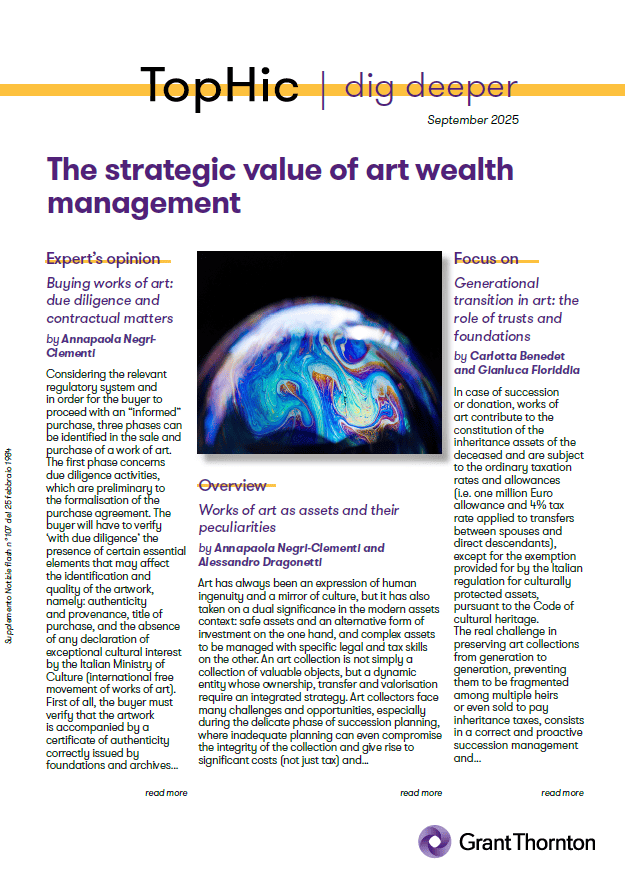
Considering the relevant regulatory system and in order for the buyer to proceed with an "informed" purchase, three phases can be identified in the sale and purchase of a work of art.
The first phase concerns due diligence activities, which are preliminary to the formalisation of the purchase agreement. The buyer will have to verify ‘with due diligence’ the presence of certain essential elements that may affect the identification and quality of the artwork, namely: authenticity and provenance, title of purchase, and the absence of any declaration of exceptional cultural interest by the Italian Ministry of Culture (international free movement of works of art).
First of all, the buyer must verify that the artwork is accompanied by a certificate of authenticity correctly issued by foundations and archives, or by appraisals drawn up by universally recognised experts. It is also important to check that the artwork originates from transactions or other transfers (special or universal right), tracing back the previous owners as far as possible to the moment the artwork was created (original ownership), ensuring that the seller is entitled to dispose of the artwork and that the latter is not subject to pledges, seizures or disputes. Last by not least, it should be verified that the artwork can circulate outside of Italy, as it is not subject to restrictions by the Italian Ministry of Culture due to its status as cultural heritage.
The second step concerns the drafting of the sale and purchase agreement, which has to include certain important clauses for the protection of the purchaser. Specifically, it must contain specific warranty clauses, whereby the seller expressly guarantees to the buyer, among other things, the authenticity of the artwork, its full and exclusive ownership and availability (also for the purposes of art. 1483 and following articles of the Italian Civil Code), and that the artwork is free from defects that make it unfit for its intended use or that significantly diminish its value (art. 1490 and following articles of the Italian Civil Code), as well as from pledges, encumbrances, restrictions, or third-party rights of any kind.
Finally, a few words should be said about two further important aspects that are often overlooked. On the one hand, warranty clauses relating to copyright and, in particular, to economic exploitation rights. It may actually happen that the purchaser acquires not only the artwork, but also individual economic exploitation rights that can circulate separately from the material ownership of the asset. These include the right to reproduce the image of the artwork in exhibition catalogues, merchandising materials, websites or social media profiles for promotional purposes. It is important to remember that the reproduction of an image of a work of art constitutes one of the exclusive economic exploitation rights granted to the author by the Copyright Law. Unless otherwise agreed in writing between the parties, this right is not automatically transferred with the sale of the artwork. Therefore, if the relevant reproduction right was not transferred with the purchase, the new owner cannot authorise its use by third parties (such as museums or galleries). Instead, the latter will have to request a specific licence from the artist or their successors and assigns in order to legitimately use the artwork’s image.
On the other hand, the warranty clause relating to the condition of the asset and, therefore, the recommendation to attach a condition report to the agreement. This report is a document defining the state of conservation of a work of art, containing all information on its physical condition, including a description of any damage, restoration and repairs that may have been carried out. It helps to avoid disputes over the condition of the artwork and any damage it may have suffered prior to the transfer of ownership.
Finally, going back to the legal analysis of the sale and purchase, the third and final phase concerns possible contractual irregularities, the management of which depends, once again, on its drafting. Indeed, if, after the sale, the artwork is found to be "inauthentic," i.e. if there is any "discrepancy between the asset transferred and the asset described in the contract," the buyer may avail themselves of various legal remedies depending on whether or not they have included an authenticity guarantee clause. In short, the buyer may request the termination of the agreement for default of contract for delivery of aliud pro alio, if ‘authenticity’ was guaranteed by the seller, or may bring an action for annulment due to defects in the agreement, if the sale of the work of art took place without the seller's guarantee of its authenticity. These actions have different limitation periods and different amounts of compensable damages.
